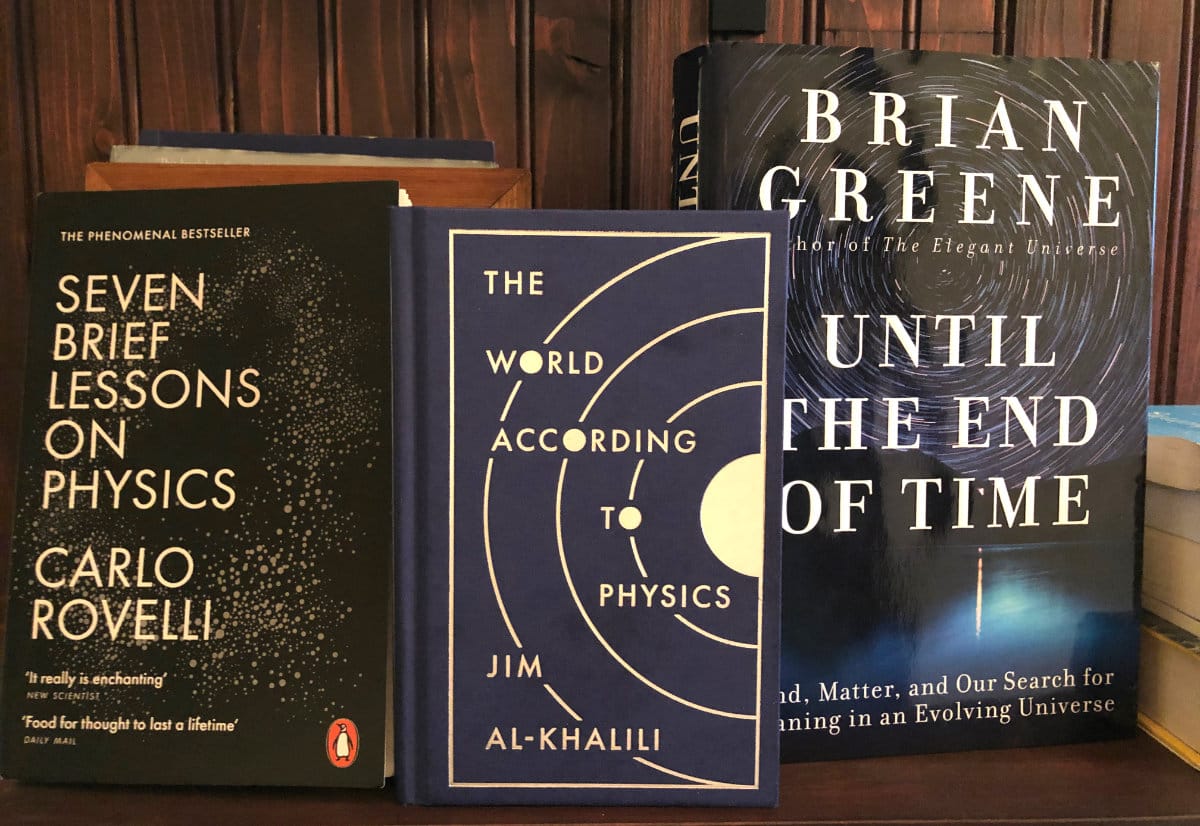
The universe in three books
During my short vacation, I looked at three books on the same subject. I have long been fascinated by discoveries about the universe. If I hadn’t had the poet’s fuzzy mind, I probably would have gone into a lot of scientific stuff, especially physics. Why didn’t I do that would be more the subject of psychoanalysis whose conclusion would exceed my small existence.
In any case, I read these books almost backward, starting with the most complex and ending with the simplest.
1. [Until the End of Time](http://www.briangreene.org/until-the-end-of-time/), Mind, Matter, and the Search for Meaning in an Evolving Universe, Brian Greene
2. [The Work According to Physics](https://press.princeton.edu/books/hardcover/9780691182308/the-world-according-to-physics), Jim Al-Khalili
3. [Seven Brief Lessons on Physics](https://www.sevenbrieflessons.com), Carlo Rovelli
The purpose of *End of Time Tool* begins with an almost philosophical statement, even if it is in perfect agreement with "reality" as we know it: In the fullness of time all that lives will die. In other words, *we will all die*, everything dies, everything plunges back into the balance of disorder. Professor of physics and mathematics, the author explains it to us in 326 pages, not in a philosophical gloss, but by describing the path of the discoveries relating to the universe and the philosophical, existential considerations that can result (what is life? for example).
It is sometimes dense, always very well written – after all, he is a successful author. The book leads us to understand the extraordinary discoveries related to our understanding of the universe, as well as it gives us a glimpse of the immense path that science still has to take to possess the truth on this subject.
As with the other two books, the conclusion is the same: the more we advance, the more we seem to move backward or instead to come up against other questions.
The second book is a better summary, in my opinion, of the state of this science. *The World According to Physics* is as devoid of complex equations as the previous book. Its purpose is to explain to people, like you and me, the wonders of the universe, as we understand it, at least through the lens of physics. This book was a real charm to read.
The third book is even shorter. *Seven Brief Lessons on Physics* is a collection of articles from a newspaper column. It is a summary of abstracts, so to speak. It may seem superficial after the more exhaustive readings, but if there is one book to explain it to your mother, this is it! With the exception of a few disturbing sentences such as :
> *The heat of black holes is like the Rosetta Stone of physics, written in a combination of three languages – Quantum, Gravitational and Thermodynamic – still awaiting decipherment in order to reveal the true nature of time.*
No wonder we lose as much of our Latin as we lose our English or our breathing.
In each of these three books, I still learned various things. So they cannot be reduced to one another even if they overlap.
Let’s try the exercise anyway:
- On the one hand, there was a first important step forward, notably with Einstein’s help (but he is really not the only one, nor the first). A simple equation will have allowed the adventure of an astonishing understanding of the infinitely great. We have made giant steps in the understanding of the mechanism of gravity (Newton’s famous apple really did not explain everything). The world of space-time, of the Big Bang, of worlds perhaps parallel or rather multiverses, has opened up before us. In these theories, the universe is curved, the time is elastic and the vision of the world can be interpeted as a trip of LSD sometimes. These discoveries have greatly inspired science-fiction authors, but also technological advances.
- On the other hand, the discovery of quanta (Plank’s hypothesis), that light is made of small quantities. It is then the adventure into the immensely small, and the results of these considerations have led us, among other things, to the smart phone, to computers, to uncertainty too since everything becomes probability. It is in the universe of the infinitely small that the study of the brain plunges with these large devices resulting from the first gravitational and thermodynamic advances. It is the universe of the minuscule that attracts the researchers of consciousness. The universe, according to this theory, is somehow *flat*. Nasty contradiction.
- Thus, between the two theories, gravitational and quantum, there is a thick opaque wall. The dance of the equations of one does not go at the same rhythm as the other, contradicts it. The two explanations of the universe, although logical, efficient, giving concrete results both in science and in our everyday life, cannot merge as they appear incompatible.
- On top of that, more than 90% of matter is foreign to us, cannot be observed. This is the *dark matter* (nothing to do with Darth Father) and its companion, the *dark energy* (nothing to do with the *Death Star*).
Physical science has now reached this point, trying to stick these two giant explanations of the universe into one big theory. It simply does not succeed. Not yet, and many physicists are already content to live with these sides of reality as best they can, while others, more stubborn, prefer to continue the uncertain adventure. Their attempts infuse more complexity to make it *elegant* as are the contradictory theories. Science is constantly searching for simplicity. The same is true of nature, which, after having taken many paths, reaches stages of simplicity. Think only of your fingers typing on a keyboard and try to understand all its movements and coordination.
My first contact with physics goes back to the vogue of pseudo-esoteric books such as *The Tao of Physics*. The temptation was great, indeed, to take shortcuts, to merge philosophy for the simple reason that the answers, the certainties still don’t come. These temptations have their usefulness too. Imagination is the best breeding ground for discovery.
Faced with the imperfections of the conclusions, we must tell ourselves that the path taken by science should not be so false since it brings us so many benefits. We are at a time when we can see the foundations of life through beautiful equations. Our reality, our poor understanding of things, the one that does not go beyond our fingers and neurons, has a lot of trouble getting used to the science-fiction universe of physics and neuroscience. What is life? What is consciousness? What is the beginning of the world? These are questions that have nourished both the sacred texts and the volumes of constantly renewed generations of philosophers and believers.
These questions are somewhat similar to those of science, and if science now accepts to make them its own, it is only on one condition: it must be verifiable and, moreover, falsifiable, that is to say that any theory can be contradicted by facts. One day or another, even if, in the meantime, one can enjoy the resulting certainties and advances. However, one must face the music. Our questions are not ready to be answered.
Now, the whole human race, impatient, seems more inclined to retreat, to want to remain in the comfort of ancient rites and in the drunkenness of blood that it can make color by the weapons of myths alone. We are facing the return of multi-faceted fundamentalism, a return to rituals that have often generated more blood than fertility. This is a sad reflex, which lacks courage.
Understanding reality and the questions that science raises is certainly not given to everyone. Nevertheless, these three books are proof that scientists believe they are more and more responsible, obliged to attempt a proper popularization.
It is a noble, almost messianic task. Artists should take hold of these explanations, make good use of them. They still need to be able to unite their inspirations with these theories. But they must have the intelligence to do so and stop worrying about their ego.
Of course, you don’t need to know all this to live your life well. You can make songs, write novels, paint pictures, make babies, dance, raise a family, and die quite peacefully.
However, it would be imperative that people be gradually educated to put their existence and their certainties into perspective. Physicists sometimes have spiritual orgasms because the reality they imagine exceeds the value of their own lives. Reading these three books also suggests that these physicists are somehow waiting for the next Einstein, Plank, Maxwell, and many others...
Science does not have answers to everything, but at least it dares to explain and question. Its stubbornness should be for each of us an example of lucidity and humility.
To read therefore, at the very least, Rovelli’s opuscule.

